Invented by Ali Yahiaoui, Candace Dyan Krautkramer, Margaret G. Latimer, Jack Nelson Lindon, Russell F. Ross, Melissa Jean Jacobs, Garry Roland Woltman, Kimberly Clark Worldwide Inc
The gel multifunctional, also known as superabsorbent polymer (SAP), is a material that has the ability to absorb and retain large amounts of liquid. It is made up of cross-linked polymers that can absorb water and turn it into a gel-like substance. This gel not only prevents leakage but also provides a dry and comfortable feeling for the user.
One of the key drivers for the growth of this market is the increasing demand for disposable absorbent products. With changing lifestyles and a growing awareness of hygiene, consumers are opting for convenient and easy-to-use products. Absorbent products containing a gel multifunctional offer a high level of absorbency, reducing the need for frequent changes and providing a sense of security for the user.
Another factor contributing to the market growth is the aging population. As the number of elderly people increases, the demand for adult incontinence products rises. These products need to be highly absorbent to ensure the comfort and dignity of the users. Absorbent products containing a gel multifunctional are able to meet these requirements, making them a preferred choice for both caregivers and individuals.
Furthermore, the advancements in technology have led to the development of innovative absorbent products. Manufacturers are constantly investing in research and development to improve the performance and functionality of these products. The gel multifunctional has been further enhanced to provide better absorption, odor control, and skin-friendliness. These advancements have attracted more consumers to switch from traditional absorbent products to those containing a gel multifunctional.
In terms of geographical distribution, the market for absorbent products containing a gel multifunctional is witnessing significant growth in both developed and developing regions. Developed countries, such as the United States and European nations, have a higher adoption rate due to the higher disposable income and awareness of hygiene. On the other hand, developing countries, including India and China, are experiencing rapid urbanization and an increase in disposable income, leading to a rise in demand for these products.
However, there are some challenges that the market faces. The cost of production for absorbent products containing a gel multifunctional is relatively high, which can limit the affordability for some consumers. Additionally, there are concerns regarding the environmental impact of disposable products. Manufacturers are working towards developing eco-friendly alternatives, such as biodegradable materials, to address these concerns.
In conclusion, the market for absorbent products containing a gel multifunctional is witnessing significant growth due to the increasing demand for convenient and hygienic products. The superior absorbency and comfort provided by these products make them a preferred choice for consumers. With advancements in technology and a growing aging population, the market is expected to continue its upward trajectory. However, manufacturers need to address cost and environmental concerns to ensure sustainable growth in the long run.
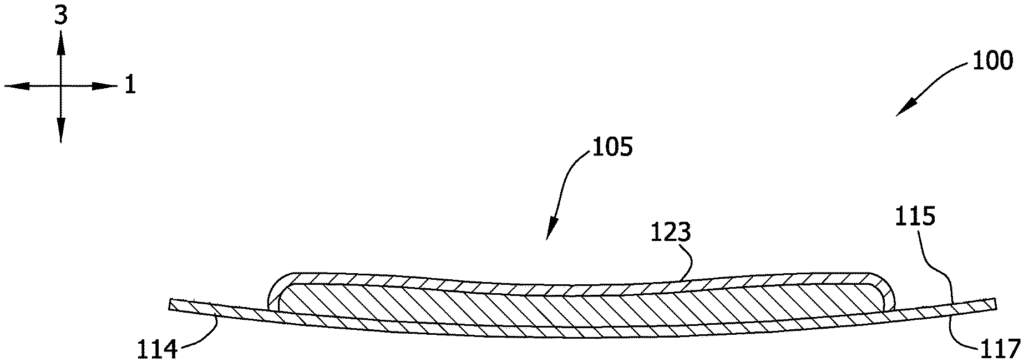
The Kimberly Clark Worldwide Inc invention works as follows
The disclosure is “improved skin adhesive compositions” for bonding an absorbent item to the skin. The skin-adhesive formulation has a gentle adhesion, but is still strong and effective when bonded to non-skin substrates. In one embodiment, a skin-adhesive formulation can provide one of more skin benefit agents for the user. The skin-adhesive formulation can be applied to absorbent articles, such as a sanitary towel, incontinence product, or a pants liner.
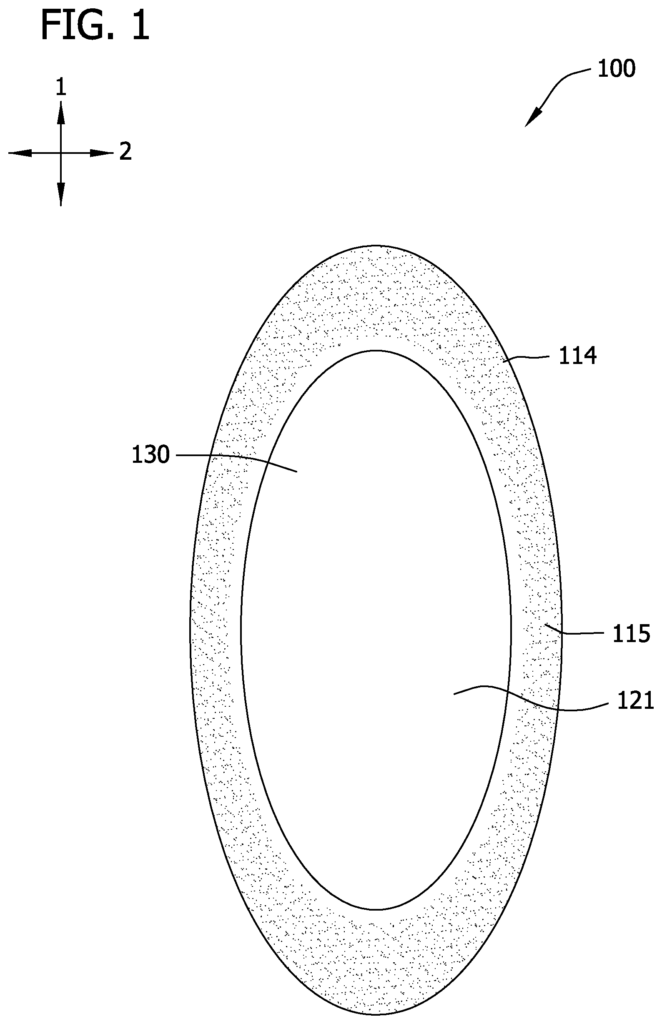
Background for Absorbent products containing a gel multifunctional
The present disclosure is a general description of absorbent articles used to hold and absorb bodily fluids. It is more specific to absorbent products that contain gels with adhesive or absorbent properties. It has also been discovered that gels with both adhesive and absorptive qualities can be incorporated into articles. The present disclosure is directed to an absorbent product, such as a sanitary towel, incontinence pad, or a pants liner, that has the skin-adhesive gel composition on it for adhering to the user’s skin and absorbing bodily liquids.
The art is well-known for “Absorbent Personal Care Articles intended to absorb discharged body fluids. These absorbent articles are generally made up of a fibrous core or another absorbent material that can absorb and retain body fluids. It is also well-known that feminine care products have been used to absorb and retain liquids such as menses and urine. In the past, absorbent articles were made up of a back sheet that was fluid-impermeable, a top sheet that was fluid-permeable, and an absorbent center positioned in between. In the past, absorbent articles included other features that improved fluid handling. These include intake layers, diffusion layers, retention layer, etc. The top sheet of these absorbent articles is the side facing the body, and the back is the side facing the garment.
In the case where pads or pantyliners are used, they can be attached to the underwear of a user by placing an adhesive on the garment-facing side of the back sheet. The current methods for attaching an absorbent product to underwear of a user include using adhesive on the garment facing side of the backsheet and, optionally or alternately, using flaps that extend along the longitudinal sides of absorbent articles which wrap around crotch area of underwear.
The U.S. application Ser. No. No.
There is a need for absorbent products that contain materials that are multifunctional, and specifically materials that offer both adhesion and absorption to the wearer. These absorbent articles will be less complex. A material that is both absorbent and adhesive will move with the wearer’s body, preventing leaks during periods of increased activity. This material would also reduce the gap between the material’s surface and the wearer’s body, thereby increasing fluid intercept.
BRIEF DISCLOSURE DESCRIPTION
It has been discovered that skin-adhesive gel compositions are easily produced and can be included in absorbent products to improve the bonding of substrates and articles with the skin. The use of skin-adhesive gel compositions within absorbent articles can reduce the gap between the material and wearer, thereby increasing fluid capture and reducing fluid leakage. The skin-adhesive gel compositions disclosed herein generally include hydrogels or aerogels which are both skin-adhesive as well as absorbent. The skin-adhesive gel compositions have been found to allow the adhesives to retain their bonding strengths with the substrate, and improve bonding with the skin while remaining gentle on the surface of the skin. The skin-adhesive gel composition can include at least one skin care agent to improve the user’s skin health.
The skin-adhesive gel composition can be applied to a variety of substrates. In one embodiment, for example, the skin adhesive and absorbent gel composition can be applied to the fluid-impermeable side of the absorbent article’s substrate. “Absorbent articles can include, for instance, a sanitary towel, incontinent article, or a pantyliner.
In one aspect, the disclosure consists of an absorbent product that consists of a fluid-impermeable substrate with a body-facing and garment-facing surfaces. The skin-adhesive gel composition is applied to the body-facing side of the substrate for direct adhesion and absorption by a wearer.
Another aspect of the disclosure is an absorbent product that comprises a fluid-impermeable substrate and an absorbent core, with a perforated lining. Fluid impermeable surface has both a body facing surface and a garment facing surface. The absorbent core, which is composed of an absorbent gel composition, is interposed between substrate and perforated lining.
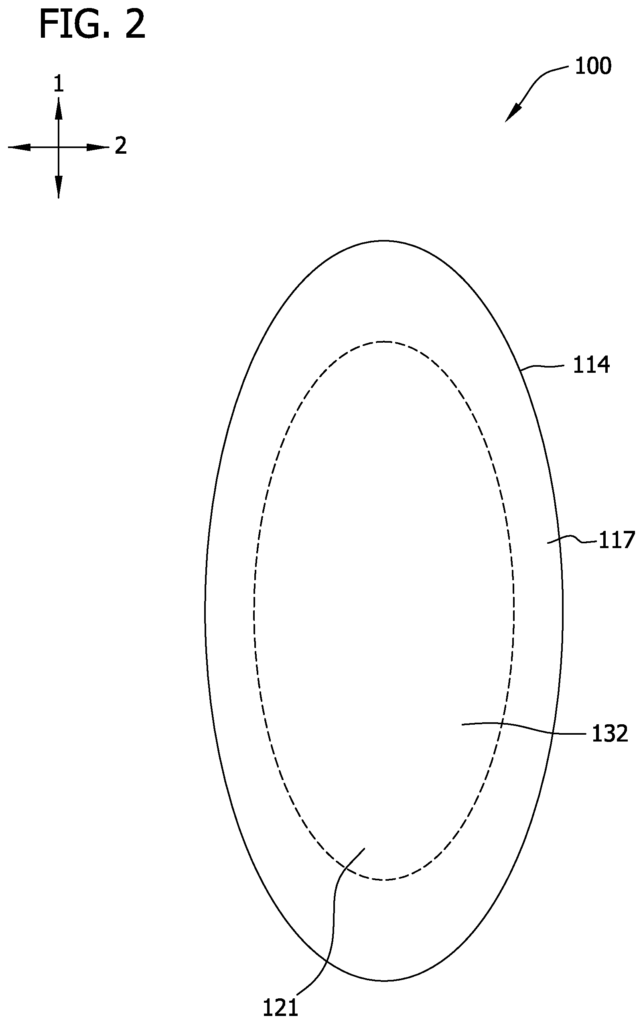
Other objects and features are described in the following paragraphs.
Referring to Figure 1, “Referring Now to FIG. The number 100 is assigned to an absorbent product constructed in general accordance with principles of the current disclosure. As shown in FIGS. The absorbent article 100 is characterized by a longitudinal 1 and a horizontal 2 direction. A substrate 114 is one component of the absorbent material 100. The substrate 114 is shown with a first surface 115 in FIG. 1 and a secondary side 117 as shown in FIG. 2. The substrate 114 provides the overall shape or silhouette of the article absorbent 100. The substrate 114 provides an additional surface for adhesion or attachment of the absorbent articles 100 to a wearer’s body.
The first side 115 is the side facing the body of the substratum 114, and the second is the side facing the garment. The first side of the substrate is designed to be in contact with the skin.
The absorbent article 100 is composed of a skin-adhesive, absorbent gel composition attached to the first surface 115. The gel composition has two sides: a first one 130, which is the side facing the body and a second 132, which is the side facing the garment.
The substrate 114 should be shaped and sized so that its first side adheres or contacts the skin around the vulva region and the pubic area of the wearer. The skin-adhesive gel composition 121 has been sized and shaped in such a way that the first side of the gel composition generally contacts the vulva area of the wearer. “The first side 130 is what holds an absorbent article on the body.
The absorbent article 100 is designed to adhere on the body part of a wearer to be absorbed bodily fluids. In one application, the absorbent articles is attached around or to the vulva area of the female wearer’s body. To or around the vulva area, the term refers to adjacent areas of a woman’s body, including the vulva and pubic regions. The absorbent article can be used to line the panty or as an incontinence product when applied around or on the vulva area of the female’s body. The absorbent articles can also be used as a substitute for underwear, since they do not require underwear to keep them in place. The absorbent article can be worn as an underwear alternative to protect the vulva region by creating a barrier that separates the outer clothing from the vulva. The absorbent article, when worn as a substitute for underwear, protects the outer clothing from bodily discharges that come from the vulva area of the body. The absorbent article can also be worn as an alternative to underwear to protect sensitive skin of the vulva area from the roughness of outer clothing. This helps to prevent or relieve irritation of sensitive skin of the vulva. The absorbent article is described as a feminine personal article, such as a sanitary napkin or pantyliner, but it can be any other absorbent item in the personal care arts, and the user does not have to be female.
The Substrate
The substrate 114 for the absorbent article can be made from different materials. The substrate can include a layer made of any material that is fluid-impermeable. The substrate 114 can include, for instance, a polymeric fabric, a woven or nonwoven fabric, or combinations thereof. The substrate 114 can include, for example, a polymer laminated with a woven or a nonwoven fabric. In FIG., a laminate substrate 114 is shown. 5 has an upper layer (141) and a bottom layer (142), where the upper layer is the side facing the body of the substrate and the lower is the side facing the garment. The polymer film in a specific embodiment can be made of polyethylene or polypropylene. It could also include silicone, polyester, or combinations thereof. The polymer film can also be micro-embossed or printed with a design, a message for the consumer and/or be partially colored.
The substrate 114 is able to operatively allow a sufficient flow of air and moisture out of the absorbent composition 100, especially out of a skin-adhesive gel composition 121, while blocking the flow of bodily liquids and the odors associated with body fluids. A breathable microporous material, like those described, for example, in U.S. Pat., can be used as an example of a substrate. No. This patent is incorporated by reference in all pertinent and consistent ways. In the present disclosure other substrate materials that are extensible can be used, such as foams. A polyurethane with a negative Poissons coefficient is an example of a foam that can be used. U.S. Pat. describes examples of materials for extensible backsheets. No. No. Polyurethane, for example, or other materials that are naturally breathable can be used as the substrate 114.
In one embodiment, the substrate 114 can be a laminate made of a woven fabric or nonwoven fabric and silicone polymer. The silicone polymer will cover the first side of the substrate 115 and will cover the second side of the substrate 117. Bio Med Sciences, Inc., Allentown, Pa., offers an OLEEVA fabric laminate. OLEEVA FABRIC consists of silicone sheeting with adhesive properties, laminated onto a fabric backing. The silicone sheeting is used to form the first surface 115 that faces the body of the substrate. Referring to FIG. The silicone polymer layer 141 is on the top of the substrate, and the nonwoven/woven layer 142 is at the bottom. In one embodiment, a polymer film can be composed of silicone, polyester, polyethylene or polypropylene. The polymer film can also be micro-embossed or printed with a design, a message for the consumer and/or be partially colored.
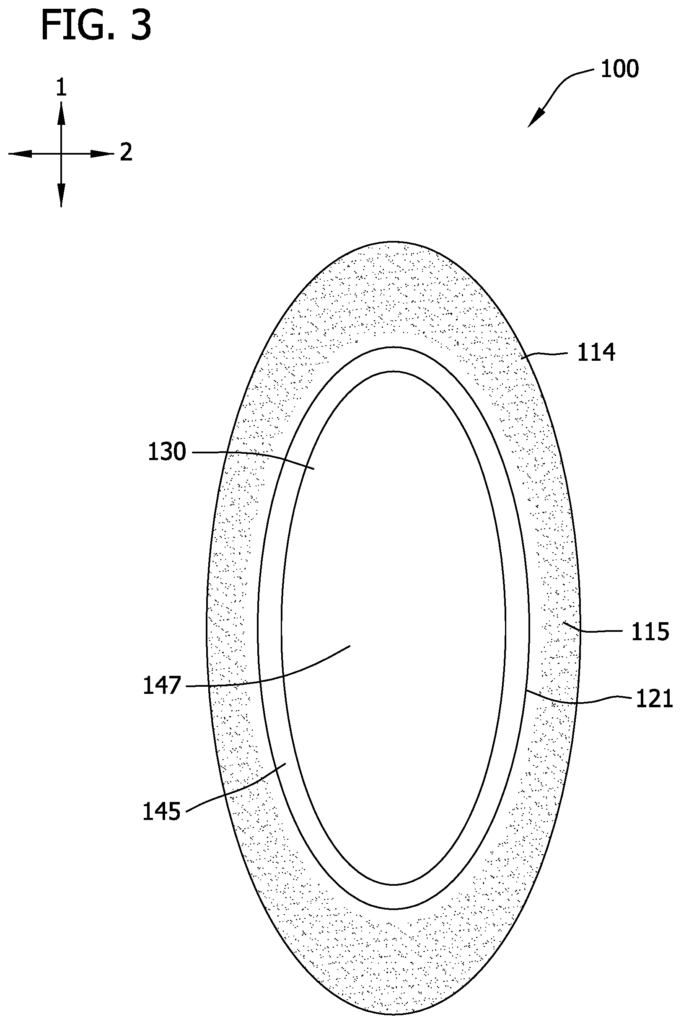
The substrate 114 can also consist of multi-component or bicomponent films. As well as woven or nonwoven fabrics that have been treated so they are liquid-impermeable, these can also be used to make a substrate 114. Foams are another suitable substrate. Foams include closed-cell polyolefin, foams with a Poissons coefficient of -1 and similar foams. Polyurethane, silicone or other polymeric materials are also suitable.
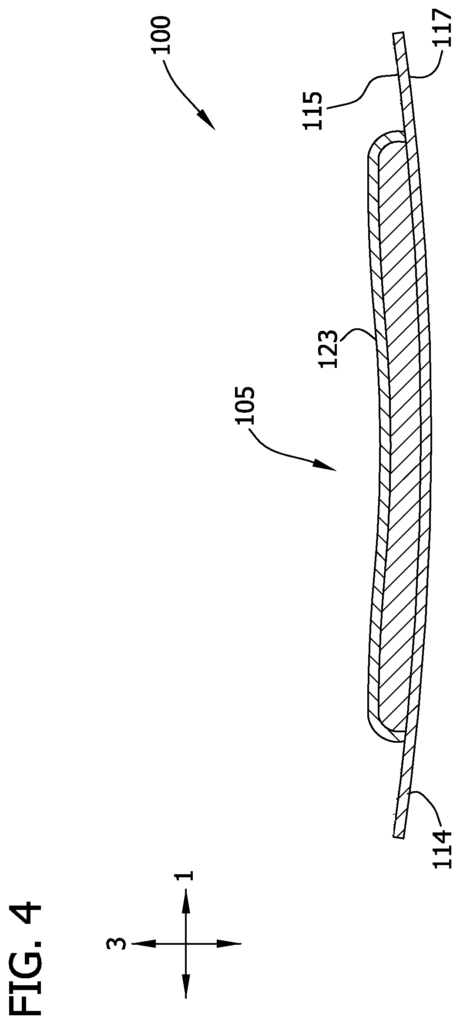
Click here to view the patent on Google Patents.
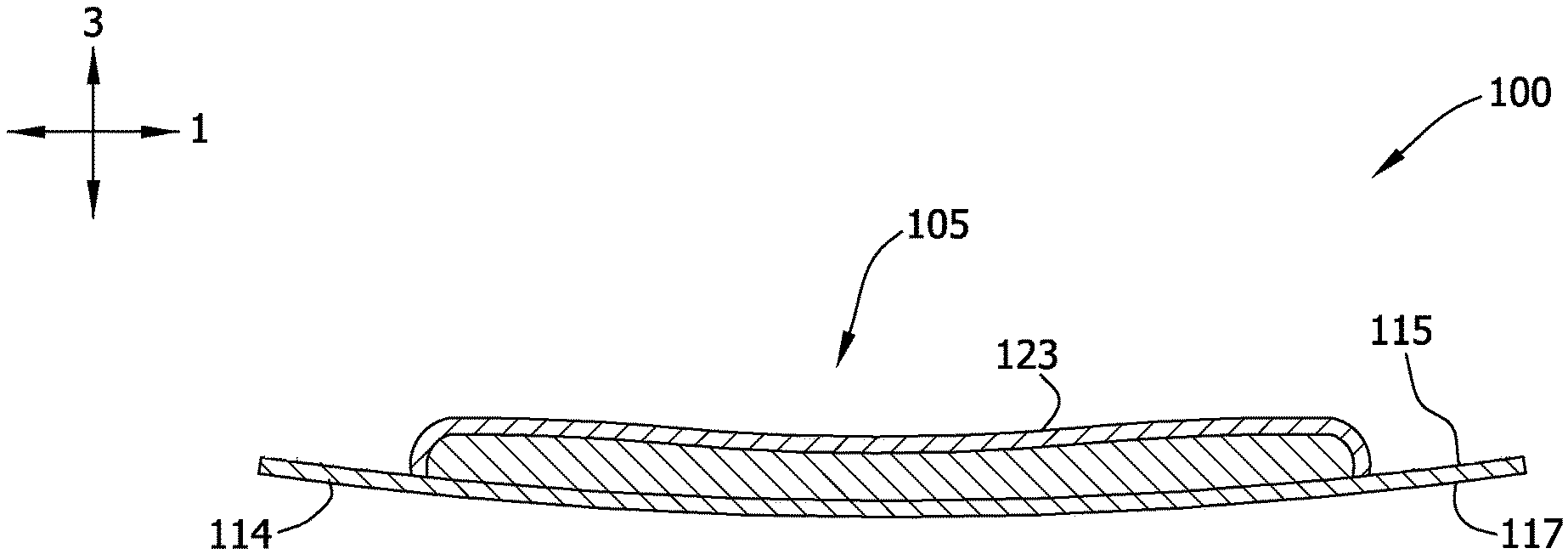
Leave a Reply